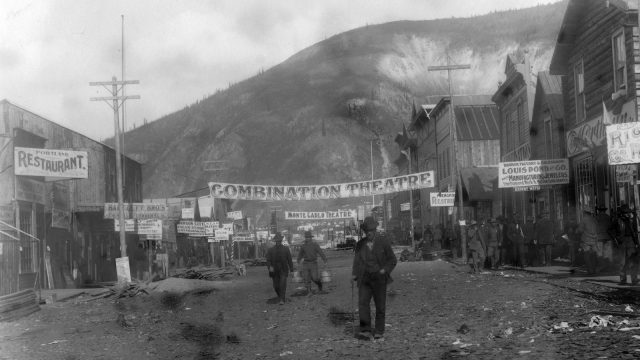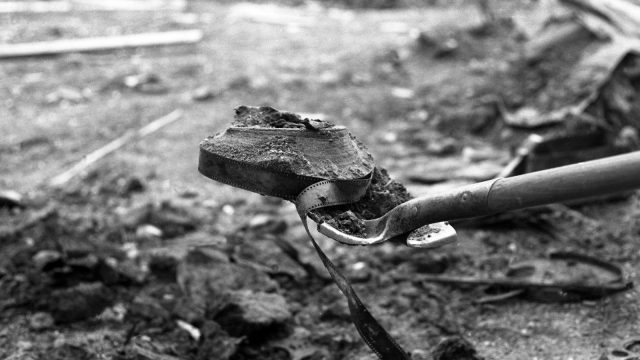
Bill Morrison follows the boom and bust of a Yukon gold-rush town in Dawson City: Frozen Time
DAWSON CITY: FROZEN TIME (Bill Morrison, 2016)
IFC Center
323 Sixth Ave. at West Third St.
Opens Friday, June 9
212-924-7771
www.ifccenter.com
billmorrisonfilm.com
 “What power has gold to make men endure it all?” a title card asks in William Desmond Taylor’s 1928 silent film, The Trail of ’98, based on a novel by Robert Service. Both Taylor and Service were at one time residents of Dawson City, the town in the Yukon in Canada that was at the center of the Klondike Gold Rush in the late 1890s. In June 1978, while construction was just under way to build a new recreation center behind Diamond Tooth Gertie’s Gambling Hall in Dawson, Pentecostal minister and city alderman Frank Barrett uncovered a treasure trove of motion picture stock, hundreds of silent films that had been believed to have been lost forever. Writer, director, and editor Bill Morrison uses stunning archival footage from those films in his elegiac, beautiful documentary, Dawson City: Frozen Time, which brilliantly tells the story of greed, perseverance, and the growth of the entertainment industry in the late nineteenth and early twentieth centuries. After gold was discovered in Dawson, the indigenous Hän people were relocated to Tr’ochëk and some hundred thousand prospectors stampeded in, the gold mining destroying the Hän’s fishing and hunting grounds. Morrison also follows the invention of film itself, celluloid stock that would end up causing many fires, including one every year in Dawson for nine years. Bookended by an original interview with Michael Gates, Parks Canada curator of collections, and his wife, Kathy Jones-Gates, director of the Dawson Museum, the film traces the boom-and-bust fortunes and misfortunes of Dawson, as gambling casinos, movie theaters, hotels, and restaurants are built, including the Arctic, a hotel and restaurant owned by Ernest Levin and Fred Trump, the president’s grandfather, that might have served as a brothel as well. The film is supplemented with photographs by Eric A. Hegg, a giant in the field who left behind glass plates when he ultimately departed Dawson. Among others making their way through Dawson at one time or another are newsboy Sid Grauman, who went on to build Grauman’s Chinese Theatre; New York Rangers founder Tex Rickard; comic superstar Fatty Arbuckle; and Daniel and Solomon Guggenheim, who dominated the mining there.
“What power has gold to make men endure it all?” a title card asks in William Desmond Taylor’s 1928 silent film, The Trail of ’98, based on a novel by Robert Service. Both Taylor and Service were at one time residents of Dawson City, the town in the Yukon in Canada that was at the center of the Klondike Gold Rush in the late 1890s. In June 1978, while construction was just under way to build a new recreation center behind Diamond Tooth Gertie’s Gambling Hall in Dawson, Pentecostal minister and city alderman Frank Barrett uncovered a treasure trove of motion picture stock, hundreds of silent films that had been believed to have been lost forever. Writer, director, and editor Bill Morrison uses stunning archival footage from those films in his elegiac, beautiful documentary, Dawson City: Frozen Time, which brilliantly tells the story of greed, perseverance, and the growth of the entertainment industry in the late nineteenth and early twentieth centuries. After gold was discovered in Dawson, the indigenous Hän people were relocated to Tr’ochëk and some hundred thousand prospectors stampeded in, the gold mining destroying the Hän’s fishing and hunting grounds. Morrison also follows the invention of film itself, celluloid stock that would end up causing many fires, including one every year in Dawson for nine years. Bookended by an original interview with Michael Gates, Parks Canada curator of collections, and his wife, Kathy Jones-Gates, director of the Dawson Museum, the film traces the boom-and-bust fortunes and misfortunes of Dawson, as gambling casinos, movie theaters, hotels, and restaurants are built, including the Arctic, a hotel and restaurant owned by Ernest Levin and Fred Trump, the president’s grandfather, that might have served as a brothel as well. The film is supplemented with photographs by Eric A. Hegg, a giant in the field who left behind glass plates when he ultimately departed Dawson. Among others making their way through Dawson at one time or another are newsboy Sid Grauman, who went on to build Grauman’s Chinese Theatre; New York Rangers founder Tex Rickard; comic superstar Fatty Arbuckle; and Daniel and Solomon Guggenheim, who dominated the mining there.

Discovery of long-lost silent films tells a fascinating story in Dawson City: Frozen Time
Morrison, whose previous films, including Decasia, The Miners’ Hymns, and The Great Flood, employ archival footage to often tell historical tales, uses thousands of clips in Dawson City: Frozen Time, from newsreels to such films as Temperance Town, The Half Breed, The End of the Rainbow, and The Frog. Footage from the found clips, identified as “Dawson City Film Find” on the screen, also delves into the evolving battle between workers and owners, the deportation of political radicals, and the Black Sox scandal, all of which Morrison relates to the upstart movie industry. The film is a tour de force of editing, as Morrison streams together scenes of actors going through doorways, kissing, or moving in vehicles, not just a torrent of random images, all set to Alex Somers’s haunting experimental score. (Somers’s brother, John, is the sound designer.) The film also sets a new personal high for Morrison, clocking in at 120 minutes, by far his longest work; all of his previous features are less than 80 minutes, but this latest one further establishes that Morrison’s mesmerizing but unusual visual approach is not time-sensitive. With Dawson City: Frozen Time, Morrison has created a magical ode to the history of film, to preservation, to pioneers, and to perseverance, told in his hypnotic, unique style. It opens at IFC Center on June 9, with Morrison and Alex Somers participating in a Q&A at the 6:00 shows on June 10 and 11, moderated by NYU Cinema Studies assistant professor Dan Streible.